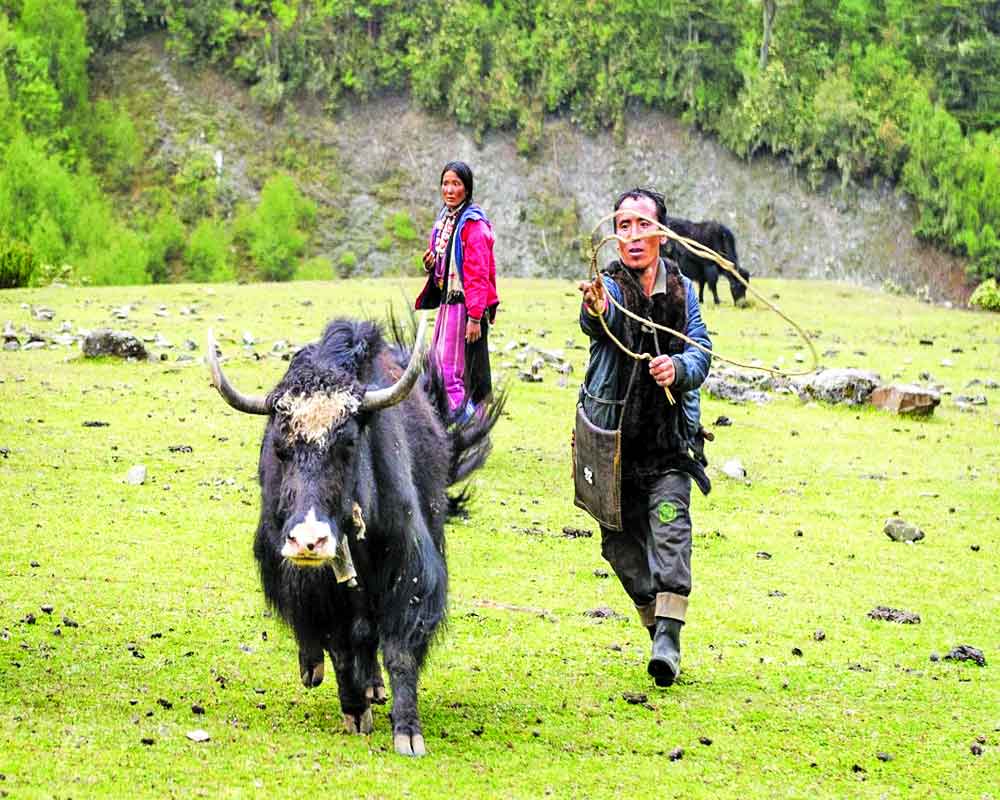Yak breeding is done in Arunachal Pradesh by the Brokpas. Now scientific methods are being employed to conserve Yak, with immense potential
Indigenous traditional knowledge of Yak breeding and management by the Brokpa (Yak rearers) community is practiced both in West Kameng and Tawang districts of Arunachal Pradesh to conserve the animals through the adoption of traditional breeding methods, classifying the animals, diagnosis the diseases and preventing the disorders and diseases by using locally available ethnoveterinary practices. However, over the years, the need was felt to undertake a scientific survey of breeds leading to the generation of information like demographic and geographical distribution, the native environment and enumeration in terms of age, sex in a population, management practices, and utility, quantitative and qualitative characterisation of Yak about morphological traits, production potential, and reproductive status and qualitative and quantitative description of unique animals, elite producers and rare or unusual characteristics in certain specimens. Considering the above mentioned aspects, a survey plan was developed for 24 months. A technical program was adopted to conduct scientific surveys of Arunachali
Yak by following modern sampling designs in suitable formats. The scientific and contemporary descriptors and questionnaires were followed to collect all possible relevant information in its defined zoo-geographical zone.
The survey was conducted in two Yak rearing districts of West Kameng and Tawang and nine persons from these two districts were selected and trained at the Yak farm of the Indian Council of Agricultural Research (ICAR)- National Research Centre on Yak (NRCY) to conduct the survey. In this survey, Arunachali Yaks were surveyed for different breed characteristics which included calves upto one year, stock from one year to three years, and adults of three years and above including milking females. These animals were surveyed from a total of 47 households from Jang, Thaingbo, Sharon, Rho, Jangda, Zemithang, and Tawang of district Tawang and Mandala top, Banglejeb, Shingchang, NagaGG, Dongchikpu, Wangdorpo, Tseskang and Nyukmadung of West Kameng district. According to the 19th Livestock Census,2012, the population of Yak was 13, 758. Arunachali Yak varies widely in coat color; even in a single herd, a mixture of different phenotypes exists. Based on body conformation and hair pattern Yaks are categorized into different types.
The most predominant common type of Yaks is small-sized, docile in temperament, and predominantly used for milk purposes. Although Arunachali Yak is also used for meat, wool as well as a pack animal. In the survey report, a total of 1400 Arunachali Yak were surveyed for different breed characteristics. This number includes 270 calves upto one year,480 stocks from one year to three years, and 650 adults of three years and above.
The survey report indicated that individual Yak productivity is only one of the criteria considered by Yak herders in maintaining their herds or maintaining white coat colour is more profitable if Yak is reared for wool. Black (85%) is the predominant coat colour of Yak which is followed by dark brown, light brown, white brown, white, and grey. Although the majority of animals are with back hair (86%) coat pattern, several animals are also found with brown hair. Yak wool is another production trait having vast economic importance. The Yak hair is a valuable and essential item for Yak farmers. Traditionally, the down and the coarse fibers depend on the fiber length, the position of the body from which the hair is derived, and the down content. The long hair that grows on the fore and rear ends of the body and on the legs is used to make ropes for tying up tents, bags, rugs, slings, sacks, and caps. The average age of clippings of hair is 12-18 months and per clipping average of 1.5 kg is collected per animal.
According to the survey report, the milk yield of female yak is very low compared to other bovine or hill cattle and lactation month hardly goes up to seven months. On average, individual female Yak has six months long lactation producing approximately 185 kg of milk in 180 days of lactation length. The peak milk yield is observed during the second and third months of lactation producing an average of 1.1-1.6 kg of milk. The overall daily milk yield of Yak in West Kameng is (1.04 kg) which is slightly higher than Tawang district (0.98 kg). This may be because of the availability of more green pastures as well as scientific intervention in West Kameng than Tawang district.
Although the amount of milk produced by Yak is of less quantity but is sufficient to prepare different milk products like cheese, paneer, etc. due to the high fat (7.45%) and SNF (11.5%) in Yak milk. Another productive trait of Yak is pack performance. The male Yak has a working life of 10-12 years. The Yak bull which is not used for breeding purposes is castrated at an early age and used for carrying a load. A Yak bull or dzo can carry between 40 to 70 kgs depending on the body condition of the animals which is highly influenced by the feed and weather conditions.
The report recommended that the conservation of Yak should be ensured by setting up nucleus breeding herds; improvement of reproductive and productive traits by genetic selection and an incentive to select for a higher yield in Yak is most likely to arise with an expanded market for milk destined for sale.
(The writer is a senior journalist and Chairman, Panwar Group of Institutions, Solan, Himachal Pradesh. The views expressed are personal. This is the concluding part of a three-part series.)
























